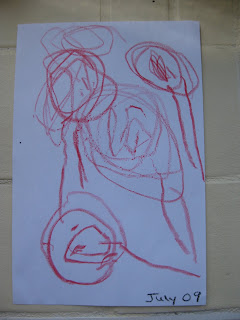Children's Art: Stages of Development Drawing
 (Artwork at 3 yrs and 1 month)
(Artwork at 3 yrs and 1 month)Stage 1. Scribble Stage (ages 2-3) This stage is basic to the child's development. At this stage just the movement of hand, arm and body is satisfying and important. The child has something that he/she alone has made. Long before the child can draw circles, rectangles, squares or other shapes in outline form he/she sees them in his /her scribbles.
 (Artwork at 3 yrs and 4 months)
(Artwork at 3 yrs and 4 months)Stage 2. Outline Shapes (age 3-4) With increased muscular control and development comes that glorious day in a child's life when he/she grasps his/her crayon firmly in his/her hand and with a single line draws a shape he/she sees and likes in his/her scribble. He/she can outline shapes. He/she draws circles, ovals, rectangles, and Xs. At least that's what the adult sees, but to the child they are just pleasing shapes.
Stage 3 & 4. The Child and Design (ages 3-5) As soon as the child can draw shapes in outline form he/she can combine shapes in design. He/she can place shapes side by side or one inside the other. He/she begins to put shapes together in a very pleasing fashion.
Stage 5 & 6. Circles, Suns and Radials (ages 3-5) Beginning at age 3 most children begin to draw circles and place crosses within them. In the self-taught art of children this shape is one of their favorites probably because of its pleasing balance. After making it many times it soon suggests the sun and center markings soon disappear and their lines cross the outside of the circle and the sun emerges.
 (Artwork at 3 years 5 months)
(Artwork at 3 years 5 months)Stage 7 Soon the child begins to experiment further by drawing lines from a point or a very small circle. These are called radials and she/he likes them so well that he/she makes them over and over. Later they become wheels, whiskers, fireworks or flowers.
 (Artwork 3 years 11 months)
(Artwork 3 years 11 months)Stage 8&9 People (ages 4-5) About age 4 children begin to draw people -not as we know them, but what they mean to them. This follows soon after the sun and radial stage. The sun becomes the human face, at first very large, to which the legs and arms are attached. Some children become very interested in adding lots of balance to the top of their drawings by drawing hats or hair.
Stage 10: Animals (ages 4-5) Following humans, the child draws pictures of animals that stand on 2 legs. The child simple puts two ears on top and uses sun's rays for fingers or claws.
Left to him/herself the child will draw representationally when she/he is ready. Children are not all ready at the same age. This is dependent upon social, mental, and physical maturity of each child. A child who has been exposed to crayons and paper at an early age will be ready to draw long before a child who has had none. Children all over the world make their early drawing in much the same way, building upon natural creative impulses. We must be careful not to destroy impulses by dictating to them what they must draw or imposing ideas. (Mayesky: Creative Activities for Young Children)
Thanks for this post--very interesting! I love learning the developmental reasons for things, but I don't always take the time and do the investigating myself. So kudos to you! :)
ReplyDeleteGreat post! There is a fantastic book by Rhoda Kellog (Kelogg?) about developmental stages of art in children around the world that you might find interesting as well. It has lots of illustrations and goes into lots of detail about why children love certain patterns.
ReplyDeletewow! thanks for the post! i teach preschool & have never heard the development of art spread out like that! very helpful!!!
ReplyDeleteI always learn so very much from your blog that helps me with my own little ones. Thank you! I gave you a blog award over on my site.
ReplyDeleteIt's like you were reading my mind! My son has moved on from scribbles to forms and my husband and I were wondering if there were specific stages in drawing. So this post was very timely :)
ReplyDeleteGood article, very informative. I enjoyed your blog very much.I am following you! :) Totally!!
ReplyDeleteReally helpful post, thank you! I have a 4-year-old and a 2-year-old, so this was really interesting!
ReplyDeleteGreat to see comparisons from the different stages of art. I write about exploring creativity with toddlers and young children on www.kiddingabout.com . All kids do show progression in artistic endeavors but it is important to realise that they all express themseleves differently so don't expect them all to pass through the same stages. Interesting article - thanks!
ReplyDeleteThis is a wonderful post! I am teaching workshop for child care teachers and was wondering if I could use the information you have posted here. Looking forward to your response!
ReplyDeleteRenee
thank you for the post. i was looking to buy Day's book. what did you think of it? was it easy to read?
ReplyDeleteHmm, which book is that, I'm not recalling?
ReplyDeleteHi thank you for shring and 2 servings a day of Horlicks Growth+ contain as much proteins, the same Vitamin C,calcium,as much phosphorus,an equal amount of iron,zinc,Vitamin A .So while children are catching up on growth, they are also getting important vitamins and minerals.
ReplyDeleteVisit: Horlicks Growth+